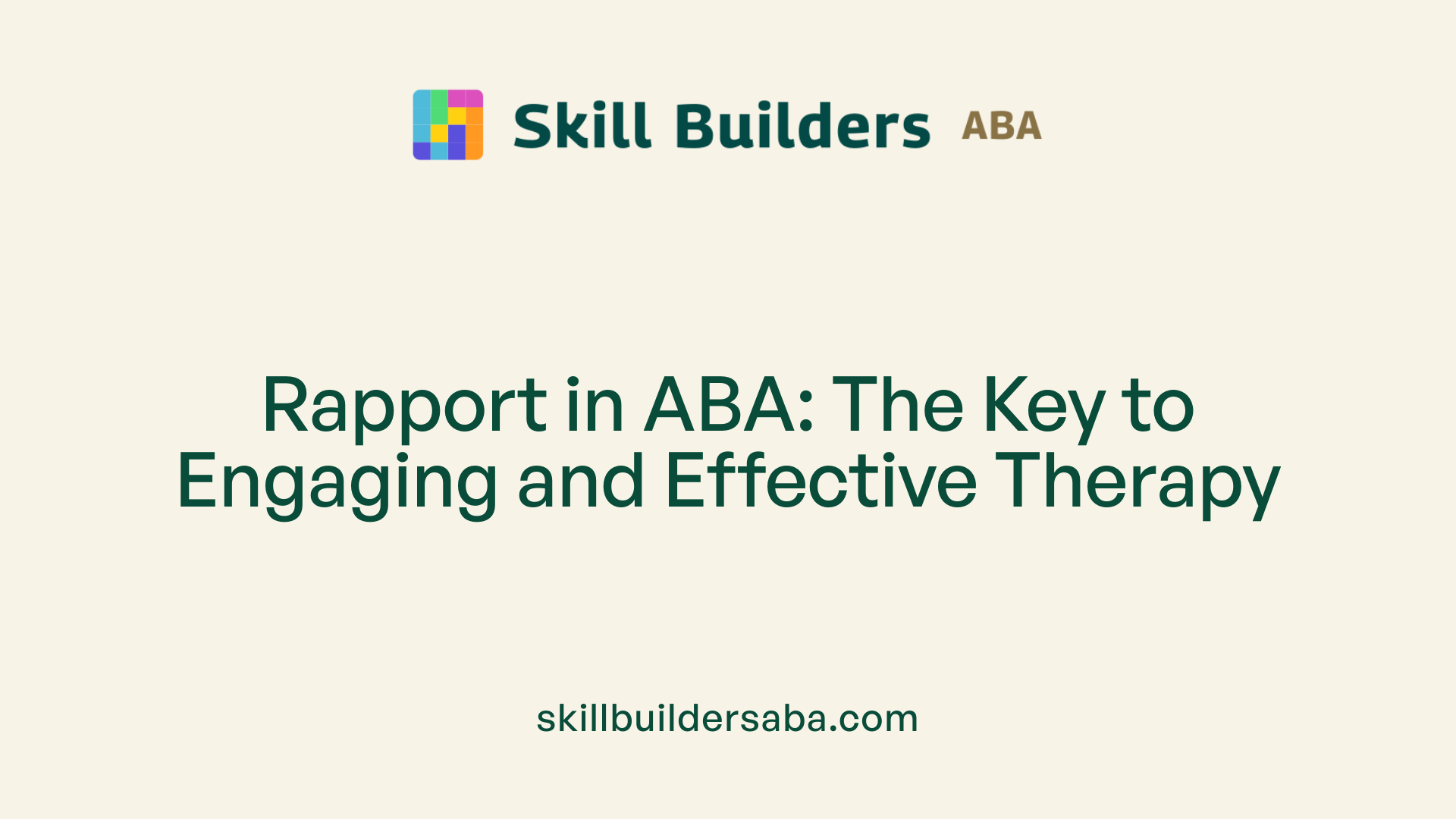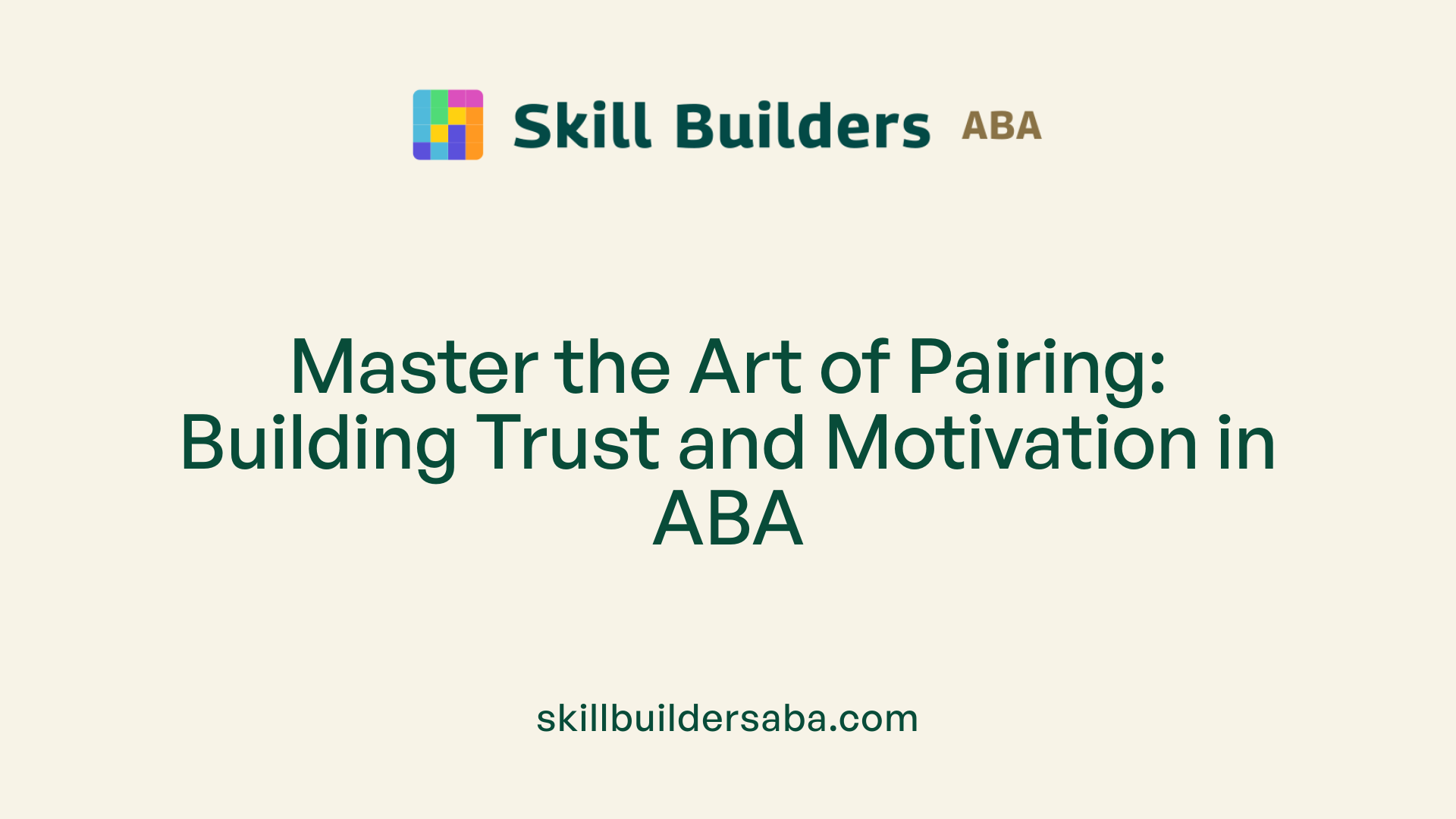
The importance of pairing in building rapport
Building Trust as the Foundation of Effective ABA Therapy
Understanding the Critical Role of Pairing in Autism Intervention
Pairing, the process of establishing a positive and trusting relationship between a therapist and a child with autism, is a fundamental element in applied behavior analysis (ABA). It serves as the initial and ongoing step in creating an environment conducive to learning, cooperation, and behavioral change. This article explores the multifaceted importance of pairing, effective strategies to implement it, and how it significantly influences therapy outcomes, especially in early intervention settings.
The Significance of Rapport-Building in ABA Therapy

What is the significance of rapport-building techniques during ABA therapy sessions?
Building rapport during ABA therapy is crucial for creating a trusting and positive relationship between the child and the therapist. This strong connection encourages the child to feel comfortable, safe, and motivated, which directly impacts their willingness to engage in learning activities.
Therapists use various strategies such as pairing, play, and effective communication to establish this bond. Pairing involves associating the therapist with preferred items and enjoyable activities, making the child view the therapist as a source of fun and reinforcement.
Incorporating play and responding to a child's interests, such as telling jokes, making eye contact, and using their name, helps foster a friendly environment. These methods reduce resistance and challenging behaviors, laying a foundation for successful skill acquisition.
Maintaining continuity in rapport-building efforts helps ensure ongoing motivation. If rapport weakens over time, it can be deliberately re-established through refreshed activities and reinforcement.
Overall, these techniques enhance engagement, decrease problematic behaviors, and improve learning outcomes. They make therapy sessions more effective by transforming them from perceived demands into enjoyable, trust-based interactions. This approach not only fosters better behavior change but also ensures that the therapy process is positive and meaningful for the child.
Core Principles and Strategies for Effective Pairing

What are the core principles of pairing in autism intervention?
Pairing in ABA centers around creating positive, trusting relationships between the therapist and the child. The fundamental idea is to associate the therapist and the learning environment with preferred activities, objects, and positive experiences. Initially, emphasis is placed on engaging the child with activities they already enjoy, without demanding compliance or challenging behaviors.
Assessment of the child's preferences is crucial. Therapists observe and gather information about what the child likes—such as toys, snacks, songs, or activities—so they can use these as reinforcers. This assessment guides the creation of enjoyable interactions that promote trust and motivation.
Consistency and individualization are essential. The process involves gradually introducing interactions that are fun and rewarding, tailored to the child's unique interests, age, and communication skills. Over time, this fosters a secure bond, where the child begins to seek out the therapist for positive experiences and feels comfortable in the therapeutic setting.
Successful pairing provides a foundation for better cooperation and engagement during therapy. It increases the likelihood that the child will view therapy as a positive experience, which ultimately supports learning and behavior change.
Is there an ABA pairing checklist or step-by-step guide for effective pairing?
Yes, many resources exist to guide practitioners through the pairing process. One commonly used tool is the 'Pairing with Reinforcement Fidelity Checklist,' developed by organizations like TASN Autism and Tertiary Behavior Supports. This checklist helps ensure all critical steps are followed systematically.
A typical guide outlines steps such as:
- Observing and identifying child's preferred stimuli.
- Engaging in non-demand interactions with the child.
- Making activities enjoyable to foster positive associations.
- Gradually introducing demands, only after establishing rapport.
- Providing continuous reinforcement to strengthen the connection.
- Fading reinforcement carefully to promote independence.
Using these structured guides helps maintain consistency, fidelity, and effectiveness in pairing efforts. They also serve as a reminder to focus on creating a positive, individualized relationship that forms the backbone of successful ABA therapy.
Strategies and Techniques for Effective Pairing

What are effective strategies and methods for pairing in ABA therapy?
Effective bonding in ABA therapy rests on creating a positive and trusting relationship between the therapist and the child. One of the foundational strategies involves engaging the child in activities they find enjoyable—such as playing with preferred toys, snacks, or engaging in sensory-social play. Using preferred items as reinforcers helps to build an association between the therapist and positive experiences.
Gradually, the therapist introduces demands once the rapport is established, typically over one to two sessions, ensuring that the environment remains fun and engaging. Consistency in offering immediate praise, narration, and reinforcement strengthens the bond. It's important to avoid placing demands during initial pairing to prevent frustration or escape-motivated behaviors.
Maintaining ongoing reinforcement and incorporating various activities keeps the environment stimulating. Monitoring the child's interests and adapting reinforcers as their preferences evolve are essential. This ongoing process helps foster motivation, reduces anxiety, and supports skill acquisition. When pairing is continuous, it reinforces the child's trust and engagement, essential for long-term learning and reducing problematic behaviors.
What are some practical examples of pairing in ABA therapy?
In practice, pairing involves the therapist engaging in activities that the child already enjoys. For example, playing with their favorite toys, singing songs, or sharing a snack can serve as positive reinforcement. Therapists often narrate their activities to make social interactions more engaging and to encourage communication.
During these sessions, demands such as instruction or task initiation are minimized. The focus remains on creating fun, relaxed interactions. For instance, a therapist might sit at the child's level, use their name frequently, or make eye contact, all while participating in play.
Shared control activities, like turn-taking games or joint attention tasks, promote social skills and eye contact, strengthening the rapport. Over time, the therapist might introduce simple requests within these engaging activities, gradually building the child's comfort with demands.
The core of pairing is to make the therapist a highly motivating figure—the ‘ultimate reinforcer’—by consistently associating interactions with positive, preferred stimuli. This foundation allows subsequent therapy activities to proceed more smoothly, with greater cooperation and enthusiasm.
The Impact of Pairing on Therapy Outcomes and Behavioral Progress

Trust, motivation, and engagement
Pairing plays a vital role in ABA therapy by fostering trust and motivation in children. When a therapist uses preferred activities, toys, or treats during initial interactions, the child begins to associate the therapist with positive experiences. This emotional connection encourages engagement, making children more willing to participate in sessions.
By allowing children to lead during pairing and focusing on enjoyable activities, therapists help reduce anxiety and resistance. The child naturally develops a sense of safety, which is essential for effective learning. As trust builds, children are more likely to be receptive to instruction and new skills, creating a solid foundation for ongoing progress.
Reduction in challenging behaviors
Building rapport through pairing can significantly decrease problematic behaviors. When children feel comfortable and positive about their interactions, behaviors such as escape or avoidance tend to diminish. The connection established between the child and therapist makes it less likely for the child to react negatively to demands.
Effective pairing strategies include providing access to preferred items without expectations, engaging in sensory-social play, and offering consistent reinforcement. These methods help the child feel valued and respected, which can lessen frustration and improve overall behavior.
Improved skill acquisition
Once a trusting relationship is established, children become more motivated to learn. The positive environment created by pairing enhances cooperation, making skill acquisition faster and more efficient. When reinforcement is closely tied to preferred items or activities, learning becomes enjoyable, encouraging children to practice new behaviors.
For example, turning learning tasks into games or incorporating preferred objects into activities increases engagement. These techniques are especially beneficial for children with autism, as they often rely heavily on reinforcement to develop new skills.
Laying a foundation for learning
Pairing sets the stage for all future interventions in ABA therapy. It creates a safe and motivating environment where the child is more likely to participate actively and willingly. This foundation helps the child to manage emotions, accept demands, and generalize skills across settings.
Importantly, pairing is an ongoing process. It should be reinforced continually and re-established after breaks or transitions to maintain a positive relationship. Consistent positive interactions lead to better therapy outcomes, higher compliance, and increased skill development.
| Aspect | Description | Examples |
|---|---|---|
| Trust and Safety | Establishes a secure base for therapy | Playing with favorite toys, using preferred activities |
| Motivation | Increases willingness to engage | Turn tasks into games, offer preferred reinforcers |
| Behavior Reduction | Decreases avoidance and escape behaviors | Creating positive associations, reducing demands initially |
| Skill Learning | Accelerates acquisition and retention of skills | Reinforcing responses with preferred stimuli |
| Long-term Foundation | Supports ongoing therapy success | Regular pairing throughout sessions and transitions |
Fostering Long-Term Growth Through Connection
In summary, pairing is more than just a preliminary step; it is the cornerstone of effective ABA therapy. Building rapport through strategic and individualized pairing techniques establishes trust, motivates children, and creates a positive learning environment. As an ongoing process, pairing continually supports the development of strong therapeutic relationships, reduces behavioral challenges, and enhances skill acquisition. For children with autism, especially during early intervention, its importance cannot be overstated. When therapy begins with a foundation of genuine connection and enjoyment, the prospects for meaningful progress and long-term growth are significantly improved. Prioritizing effective pairing practice ensures that ABA therapy is both successful and enriching for the child, laying the groundwork for a future filled with learning, independence, and confidence.
References
- The ABCs of ABA: What is Pairing & Building Rapport?
- Building Rapport using Strategies to Promote Pairing
- The Benefits of Pairing in ABA Therapy
- Pairing and Building Rapport - Autism Services Of Kansas
- The Effectiveness of Pairing in ABA Therapy - Motivity
- The Importance of Building Rapport in ABA - Behavior Nation
- Pairing: Building Relationships Before Placing Demand
- 5 Pairing Pointers: Building Rapport With Your Child
- Why building rapport is so vital to your child's success with ABA
Reach Out Today
Learn more about how we can support your child’s growth and development. Contact us to discuss our services and availability in your area.
.svg)